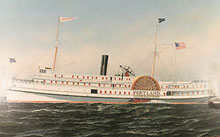
This 1981 lithograph by Antonio Jacobsen is considered one of the best interpretations of the Steamship Portland in her prime. Image: Courtesy of Maine Historical Society.
History of the Search
Provided by the Stellwagen Bank National Marine Sanctuary
Confirmation of the Portland's final resting place within the Stellwagen Bank National Marine Sanctuary is the capstone of a 20-year search conducted by the Historical Maritime Group of New England (HMGNE). HMGNE, which specializes in finding shipwrecks, is a partnership of several New England marine scientists and salvage experts who share an interest in maritime archaeology.
Circumstances surrounding the Portland's sinking remained a mystery for 90 years, until John Fish, co-director of HMGNE, and his associates, Pete Sachs and Arnie Carr, located the vessel in 1989. At the time, they were unable to produce sufficient evidence to solidly confirm the site. Funding and technological limitations prevented them from continuing their investigation, so the project was put on hold.
As time progressed, technology evolved and increased in precision. When the Stellwagen Bank area was designated a National Marine Sanctuary in 1992, the sanctuary became federally responsible to protect its submerged maritime archaeological resources. The availability of advanced technology, the development of recent multibeam sonar maps, and the prior knowledge of HMGNE all converged to set the stage for the 2002 mission that confirmed the Portland's final resting place.
Soon after the Portland sank in 1898, people began to search for the ship's remains. Popular opinion at the turn of the century said that the vessel sank on the Peaked Hill Bar, a sandbar off the northern tip of Cape Cod. These beliefs were predicated on the fact that considerable amounts of wreckage from the ship turned up on local Cape Cod beaches in the days following the storm. Furthermore, a Cape Cod lifesaver (a precursor to the U.S. Coast Guard) reportedly heard four short blasts from a steam whistle on the morning of November 27, the day the ship probably sank. These blasts were indicative of a steamer in distress.
In 1899, the Boston Globe funded a mission to find the wreck on Peaked Hill Bar. Searchers dragged a cable between two boats along the ocean floor looking for wreckage, but turned up nothing.
A half-century later, Edward Rowe Snow, a prominent author of New England maritime history, headed an investigation. In 1945, he and his colleagues recruited a hardhat diver to go down on a wreck that they believed to be the Portland. This wreck was located off the tip of Cape Cod in 140 ft of water. The diver successfully made it to the wreck and stated he thought it was the Portland, but he failed to bring up any conclusive evidence verifying the ship's identify. Snow supported this claim for years in his publications, although other maritime historians doubted its veracity.
In 1981, John Fish and his associates began to search for the Portland in an area to the north of the previously claimed site. Fish specializes in underwater search and recovery operations and is vice president of the Cape Cod-based firm, American Underwater Search and Survey. He is also a noted maritime history author and sonar expert, and with his team, he has helped with recovery operations in many commercial airline crashes.
During the search for the Portland, Fish and his colleagues at HMGNE spent thousands of hours at sea combing Massachusetts Bay looking for the vessel. In consultation with a physical oceanographer at the Woods Hole Oceanographic Institution, they recorded what washed up on the Cape Cod shores and analyzed the data with computer software that factored in possible wind and tidal drift. They plotted hourly positions for the wreckage back to a possible sinking site (based on the evidence of stopped watches found on the bodies of recovered Portland victims). Their 1989 discovery of the Portland was the culmination of nearly a decade of effort.
The HMGNE's offer of map coordinates, the sanctuary's contribution of resources, and the latest technology provided by the National Undersea Research Center at the University of Connecticut produced the clear evidence necessary to confirm that the Portland is indeed situated within the sanctuary's borders.

















